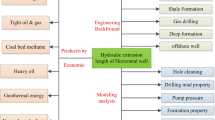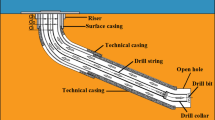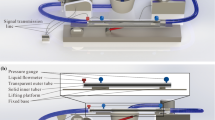Abstract
Horizontal well is of great significance to the development of unconventional oil and gas resources. Considering the wellbore cleaning and pressure system safety, a model is established based on the influence of cuttings on the hydrostatic column pressure, horizontal annular pressure drop and annular geometrical shape to provide a specific extreme horizontal extension length (EHEL). This model is controlled by minimum cutting-carry pump rate, bottomhole pressure, circulation pressure loss and drilling pump pressure. The solving process and method is also given to realize the prediction of any horizontal well. The analysis shows that there is a limit to EHEL in order to maintain the wellbore cleaning degree and effective cutting transport. The limiting factors to EHEL change from formation fracture pressure and bottomhole pressure to total circulation pressure loss and pump pressure as minimum cutting-carry pump rate increases. The EHEL increases and then keeps constant as acceptable cutting bed height increases. Higher drilling fluid density is adverse to EHEL although it can reduces minimum cutting-carry pump rate. Lower consistency index and flow behavior can increase EHEL because it can reduce minimum cutting-carry pump rate and circulation pressure drop. The carve of EHEL with rate of penetration is divided into three sections, and the rate of penetration should remain in slowdown section to balance drilling cost and EHEL.
Similar content being viewed by others
References
Hughes, J.D.: Energy: a reality check on the shale revolution. Nature 494(7437), 307–308 (2013)
Connell, L.D.; Pan, Z.; Camilleri, M.; Meng, S.; Down, D.; Carras, J.; Lupton, N.: Description of a \(\text{ CO }_2\) enhanced coal bed methane field trial using a multi-lateral horizontal well. Int. J. Greenh. Gas Control 26, 204–219 (2014)
Hou, J.; Xia, Z.; Li, S.; Zhou, K.; Lu, N.: Operation parameter optimization of a gas hydrate reservoir developed by cyclic hot water stimulation with a separated-zone horizontal well based on particle swarm algorithm. Energy 96, 581–591 (2016)
Moss, C.; Ridgway, D.: Absolute Wellbore Placement via No-Access Ranging from Surface—Alberta Experience in SAGD Horizontal Drilling. SPE Canada Heavy Oil Technical Conference, 7–9 June, 2016, Calgary, Alberta, Canada, SPE 180749
Hu, D.; Yan, J.: The factors affecting the productivity of horizontal well. Pet. Explor. Dev. 21(05), 44–52 (1994)
Mason, C.J.; Judzis, A.: Extended-Reach Drilling—What is the Limit? SPE Annual Technical Conference and Exhibition, 27–30 September, 1998, New Orleans, Louisiana, SPE 48943
Jia, L.; Chen, M.; Hou, B.; Sun, Z.; Jin, Y.: Drilling fluid loss model and loss dynamic behavior in fractured formations. Pet. Explor. Dev. 41(1), 105–112 (2014)
He, S.; Wang, W.; Tang, M.; Hu, B.; Xue, W.: Effects of fluid seepage on wellbore stability of horizontal wells drilled underbalanced. J. Nat. Gas Sci. Eng. 21, 338–347 (2014)
Xu, Y.; Guan, Z.; Zhang, H.; Zhang, H.Z.: The quantitative description of gas-cut degree in deepwater drilling. Pet. Explor. Dev. 43(2), 320–325 (2016)
Li, D.; Yang, Z.; Di, B.; Chen, S.; Wang, J.: Drag and torque reducing techniques on S-shaped directional wells of the Rumaila oilfield. Pet. Drill. Technol. 44(5), 22–27 (2016)
Sönmez, A.; Kök, M.V.; Özel, R.: Performance analysis of drilling fluid liquid lubricants. J. Pet. Sci. Eng. 108, 64–73 (2013)
Dong, X.; Wang, L.; Yang, X.; Xue, Z.: Effect of ester based lubricant SMJH-1 on the lubricity properties of water based drilling fluid. J. Pet. Sci. Eng. 135, 161–167 (2015)
Skyles, L.; Amiraslani, Y.; Wilhoit, J.: Converting Static Friction to Kinetic Friction to Drill Further and Faster in Directional Holes. IADC/SPE Drilling Conference and Exhibition, 6–8 March, 2012, San Diego, California, USA. SPE151221
Peng, W.; Hongjian, N.I.; Wang, R.; Shen, Z.; Zhina, L.I.; Peng, L.: Influence laws of modulated vibration on friction reduction in inclined-wells. J. China Univ. Pet. Nat. Sci. Ed. 38(4), 93–97 (2014)
Barton, S.P.; Baez, F.; Alali, A.: Drilling Performance Improvements in Gas Shale Plays using a Novel Drilling Agitator Device. North American Unconventional Gas Conference and Exhibition, 14–16 June, 2011, The Woodlands, Texas, USA, SPE 144416
Al-Buali, M.H.; Dashash, A.A.; Al-Shawly, A.S.; Al-Guraini, W.K.; Al-Driweesh, S.M.; Bugrov, V.; Nicoll, S.: Maximizing Coiled Tubing Reach during Logging Extended Horizontal Wells Using E-line Agitator. Kuwait International Petroleum Conference and Exhibition, 14–16 December, 2009, Kuwait City, Kuwait, SPE 127399
Li, X.; Gao, D.; Zhou, Y.; Cao, W.: General approach for the calculation and optimal control of the extended-reach limit in horizontal drilling based on the mud weight window. J. Nat. Gas Sci. Eng. 35, 964–979 (2016)
Liu, M.; Fu, J.; Bai, J.: The study of limited extension ability of shale gas double 2D horizontal well. Sci. Technol. Eng. 16(10), 29–33 (2016)
Li, X.; Gao, D.; Zhou, Y.; Zhang, H.: Study on open-hole extended-reach limit model analysis for horizontal drilling in shales. J. Nat. Gas Sci. Eng. 34, 520–533 (2016)
Xu, K.; Xiong, J.; Chen, J.; Qin, D.; Xu, H.: The evaluation and analysis of hydraulic extensions ability of horizontal section in deep horizontal wells. J. Southwest Pet. Univ. Sci. Technol. Ed. 34(6), 101–106 (2012)
Wang, J.; Zhang, W.; Yu, Z.; Li, Y.; Liu, H.; Zhang, S.: Prediction of sidetract horizontal well extension length. China Pet. Mach. 44(3), 26–29 (2016)
Li, X.; Gao, D.; Zhou, Y.; Zhang, H.: A model for extended-reach limit analysis in offshore horizontal drilling based on formation fracture pressure. J. Pet. Sci. Eng. 146, 400–408 (2016)
Liu, Y.; Fu, J.; Yanghu, Y.H.; Wen, Q.; Cui, C.; Liu, L.: Safety horizontal section length prediction of horizontal well in Changji tight oil field. China Pet. Mach. 43(8), 51–55 (2015)
Song, Z.; Li, J.; Duan, Y.; He, S.; Zheng, C.: Study on the hydraulic extension limitation of horizontal well in carbonate reservoir. Drill. Prod. Technol. 38(1), 15–18 (2015)
Jun, J.: Horizontal Extension Ability of Gas Drilling. Southwest Petroleum University, Chengdu (2014)
Chen, Y.; Dong, S.; Liu, C.: Deep-water horizontal extension mechanism of the pressure-sensitive reservoirs. World Well Logging Technol. 2, 42–44 (2015)
Bizhani, M.; Rodriguez Corredor, F.E.; Kuru, E.: Quantitative evaluation of critical conditions required for effective hole cleaning in coiled-tubing drilling of horizontal wells. SPE Drill. Complet. 31(3), 188–199 (2016)
Zhang, H.; Guan, Z.; Liu, Y.; Liang, D.; Xu, Y.: A novel tool to improve the rate of penetration by transferring drilling string vibration energy to hydraulic energy. J. Pet. Sci. Eng. 146, 318–325 (2016)
Wang, J.; Sun, B.; Li, H.; Xiang, H.; Wang, Z.; Tian, A.: Simulation analysis of cuttings velocity distribution in extended horizontal well drilling. Chin. J. Hydrodyn. 29(6), 739–748 (2014)
Zhou, B.; Liu, G.; Li, J.: Research on floating mud cap-bottom hole pressure model. Drill. Prod. Technol. 31(6), 4–7 (2008)
Guan, Z.; Liu, Y.; Liu, Y.W.; Xu, Y.: Hole cleaning optimization of horizontal wells with the multi-dimensional ant colony algorithm. J. Nat. Gas Sci. Eng. 28, 347–355 (2015)
Shen, H.; Hu, X.; Wang, L.: Development and application of the annular pressure loss analysis model for the negative differential pressure design of directional well. China Offshore Oil Gas 25(4), 49–53 (2013)
Liu, Y.; Zhou, Y.; Wang, G.; Zhai, H.; Shao, T.: Effect of annular cuttings on negative pressure in under-balanced drilling process. Acta Pet. Sin. 26(6), 96–98 (2005). 103
Erge, O.; Ozbayoglu, E.M.; Miska, S.Z.; Yu, M.; Takach, N.; Saasen, A.; May, R.: Laminar to turbulent transition of yield power law fluids in annuli. J. Pet. Sci. Eng. 128, 128–139 (2015)
Wang, H.; Liu, X.; Ding, G.; Li, H.: Development of model for pressure drop in annular space of horizontal well. J. China Univ. Pet. Nat. Sci. Ed. 20(2), 30–35 (1996)
Kelessidis, V.C.; Dalamarinis, P.; Maglione, R.: Experimental study and predictions of pressure losses of fluids modeled as Herschel–Bulkley in concentric and eccentric annuli in laminar, transitional and turbulent flows. J. Pet. Sci. Eng. 77(3), 305–312 (2011)
Chen, T.; Guan, Z.: Drilling Engineering Theory and Technology. China University of Petroleum Press, Dongying (2000)
Author information
Authors and Affiliations
Corresponding authors
Rights and permissions
About this article
Cite this article
Zhang, B., Guan, Z., Hasan, A.R. et al. Prediction and Analysis of Extreme Extension Length of Horizontal Well Based on Hole Cleaning Degree. Arab J Sci Eng 43, 2537–2546 (2018). https://doi.org/10.1007/s13369-017-2669-x
Received:
Accepted:
Published:
Issue Date:
DOI: https://doi.org/10.1007/s13369-017-2669-x




